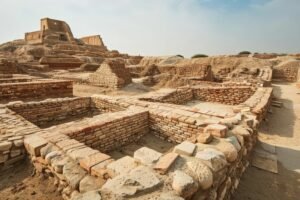Introduction
The ancient Egyptians are often celebrated for their awe-inspiring pyramids, towering obelisks, and intricate tombs. But what many don’t realize is how their groundbreaking inventions continue to influence modern engineering and technology today. From construction techniques to water management systems, the Egyptians were far ahead of their time, laying the groundwork for the innovations we rely on in the present day.
In this article, we will uncover some of the most influential ancient Egyptian inventions and explore how they still shape the world of modern engineering.

1. The Lever: A Simple Tool with Huge Impact
One of the most fundamental inventions in both ancient and modern engineering is the lever. The Egyptians mastered the use of the lever to move massive stones during the construction of the pyramids. While the pyramids are often credited to brute force, levers played a crucial role in raising heavy blocks to great heights.
In modern engineering, the lever continues to be a key principle in tools like cranes, seesaws, and hydraulic systems. Whether moving tons of materials at construction sites or designing heavy machinery, the same concept the Egyptians used is still central to modern engineering.
2. Ramp Systems: Paving the Way for Skyscrapers
The ramp systems used by the Egyptians in pyramid construction were truly ahead of their time. While we don’t know the exact layout of their ramps, there is evidence that suggests they used sophisticated inclined planes to move large stones upwards. This method significantly reduced the amount of energy required to transport materials over long distances or high places.
Today, ramps are a key feature in construction sites, as well as in the design of modern buildings. Architects use the same basic principles to create safe and efficient environments, especially for accessibility purposes. The construction of skyscrapers and bridges often incorporates ramp systems similar to those the Egyptians used, making them a timeless innovation.
3. Sundials: The Birth of Timekeeping Devices
The Egyptians were among the first to develop sundials, which used the sun’s movement to measure time. Their understanding of how shadows changed during the day laid the groundwork for the development of more complex timekeeping devices, such as clocks and watches.
In today’s world, the ability to measure time precisely is essential in everything from engineering projects to daily routines. The concept of tracking time helped engineers develop schedules, synchronize activities, and maintain accuracy in construction and manufacturing processes.
4. Water Irrigation Systems: Mastering the Nile
One of the most remarkable Egyptian inventions was their water irrigation systems, which allowed them to harness the power of the Nile River for farming. They created canals and dikes to control water flow and ensure a consistent supply of water, even in dry seasons. This mastery of water management was a major breakthrough and remains influential in modern irrigation techniques.
In contemporary engineering, water management systems are critical to agriculture and urban planning. Methods used to transport water, prevent floods, and sustain crops in arid regions echo the principles developed by the Egyptians thousands of years ago. Today’s modern irrigation systems have their roots in these ancient techniques.
5. Architectural Alignment: Designing with Precision
The Egyptians designed their temples and pyramids with astounding precision. Many of their structures, including the Great Pyramid of Giza, are aligned with the cardinal points (north, south, east, and west) or celestial bodies. This careful alignment required a deep understanding of geometry and astronomy.
Modern architecture still relies on precise measurements and orientation, especially in the construction of large buildings, airports, and solar energy systems. The Egyptians’ skill in geometric alignment has helped pave the way for advancements in modern construction techniques, ensuring that today’s buildings are structurally sound and energy-efficient.
6. Glassmaking: An Ancient Art
The art of glassmaking is believed to have originated in ancient Egypt. The Egyptians crafted beautiful glass beads and containers using a technique that was later passed on to other cultures. This ancient practice set the foundation for modern glass production methods.
Today, glass is used in virtually every area of engineering, from construction materials to technological components in electronics. The Egyptians’ innovative approach to glasswork continues to impact modern engineering, making them pioneers in an art that is still evolving.
7. The Shaduf: A Practical Water-Lifting Device
The shaduf was a simple yet brilliant water-lifting device used by the Egyptians to irrigate their fields. It consisted of a long pole balanced on a pivot, with a bucket attached to one end. This device allowed farmers to lift water from a lower area to irrigate fields that were higher up.
The principles of the shaduf are still used today in the design of modern pumps and water-lifting systems. Although modern technology has advanced significantly, the basic mechanics remain the same, showing just how timeless this invention is.
Conclusion
The legacy of ancient Egyptian inventions is still felt today, influencing a wide array of fields, particularly modern engineering. From levers to ramps, and from irrigation systems to architectural alignments, their innovations have stood the test of time, shaping the world we live in today. As we look to the future, we can continue to learn from the ingenuity of the Egyptians, ensuring their ancient wisdom continues to influence our modern innovations.











